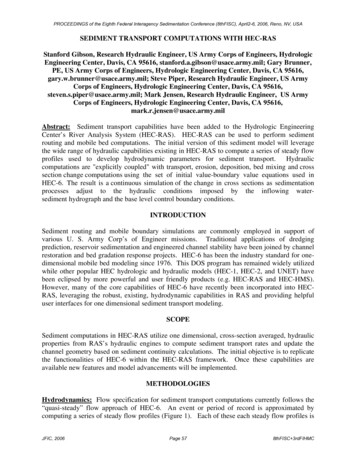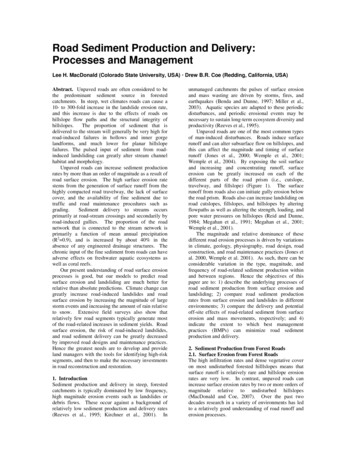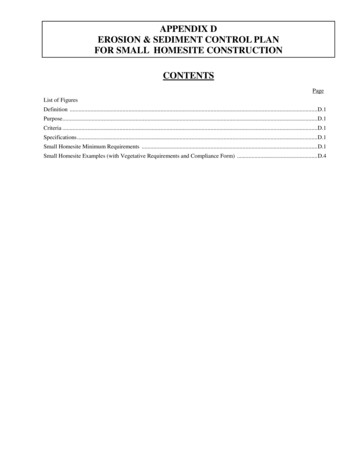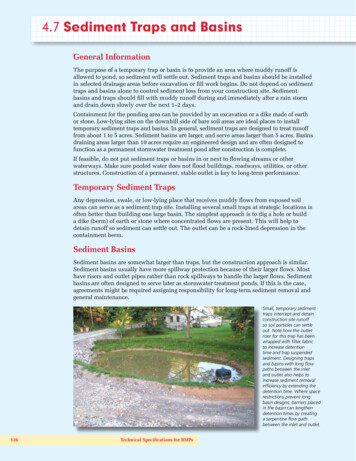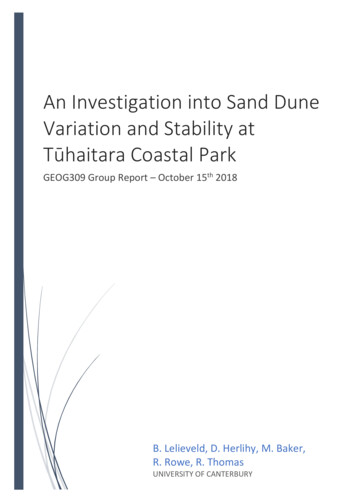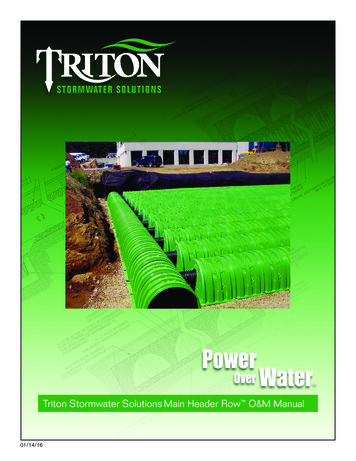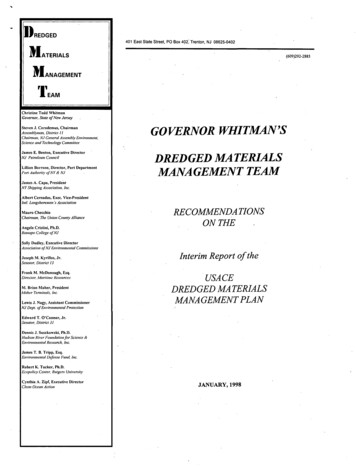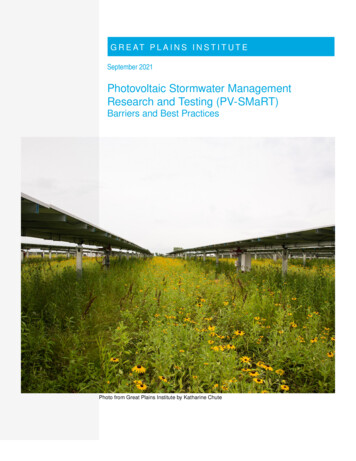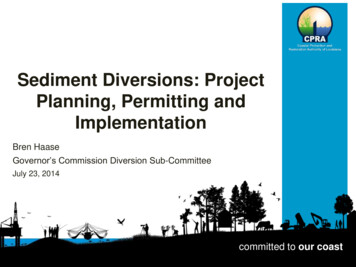
Transcription
Sediment Diversions: ProjectPlanning, Permitting andImplementationBren HaaseGovernor’s Commission Diversion Sub-CommitteeJuly 23, 2014committedtotoourcommittedourcoastcoast
When discussing the Mississippi River Commission 1894report of survey on the delta to account for the sinking landit was noted:“The conditions are very different now from those existingprior to the existence of levees. There are at present noannual accretions of sedimentary matters from the periodicaloverflows of the river. These accretions formerly were a littlemore than equal to the annual subsidence of the lands ”Coastal Protection and Restoration Authority of Louisiana
Long History of Planning Diversions are part of allCoastal Protection and Restoration Authority of Louisiana
Existing DiversionsCaernarvon Freshwater DiversionOpen: August 1991Max. Flow: 8,000 cfsDavis Pond Freshwater DiversionOpen: July 2002Max. Flow: 10,650 cfsExisting Diversions, Siphons, CrevassesCoastal Protection and Restoration Authority of Louisiana
2012 MASTER PLAN(Mississippi River Diversion Recommendations)DIVERSIONS ADVISORY PANEL , DIVERSIONS SUB-COMMITTEE & PUBLIC ENGAGEMENTLOWER BRETON(50,000 cfs)LOWER BARATARIA(50,000 cfs)FEASIBILITY-LEVEL MODELING(Site specific data collection andrefined 2012 MP Models, rivermodeling, and localizedDelft3D)MID BRETON(35,000 cfs)MID BARATARIA(50,000 cfs)WINTER 2014CPRA DECISION TO ADVANCEPARTICULAR ALTERNATIVES VIAVERIFICATION OF MASTER PLANBENEFITS AND COSTS(Land/Site/Size/Cost/Constructability)MR HYDRODYNAMIC &DELTA MANAGEMENT(River and basin sidemodeling)DATA SYNTHESIS/VISUALIZATION(SSPM and Coastal SustainabilityStudio)UPPER BRETON(250,000 cfs)PRELIMINARY DESIGN(varying levels – LCAfeasibility, 10%, 30%)EXTERNAL TECHNICAL REVIEW(Review/comparison of cost anddesign assumptions andconstructability determination)BASIN-WIDE INTEGRATEDHYDRODYNAMIC, MORPHOLOGICAL& NUTRIENTS MODELING(Analyze Sequencing and Operation ofrecommended suite of diversions)FISHERIES MODELING(CASM and EwE coupling with BasinWide Delft3D and MRHDM AdH)DECEMBER 2016CPRA/FED DECISION TOIMPLEMENT(Federal Interest Determination –Chief’s Report)MID BARATARIA(250,000 cfs)SOCIOECONOMIC EVALUATION(Social, economic, and fisheriesimpacts – past/present/future)SUMMER 2015CPRA DECISION TO IMPLEMENT(Advance to full engineering anddesign)2017 MASTER PLAN(Recommendations would beincluded as part of evaluation)SWAMP(Pre/post construction and coast-wide5monitoring, adaptive management)
Project EvaluationNonstructuralMeasuresInitial list of 1,500 projects screened with 400 evaluated usingthe predictive modeling suite.
Grounded in ScienceDecision Criteria and Ecosystem ServicesRisk ReductionOysterDistribution of flood riskacross socioeconomic groupsFlood protection of historicpropertiesShrimpFreshwater AvailabilityAlligatorExpected AnnualDamagesFlood protection of strategicassetsOperation and maintenancecostsRestorationSustainabilitySupport for navigationUse of natural processesSupport for cultural heritageLand AreaSupport for oil & gasWaterfowlSaltwater FisheriesFreshwater FisheriesCarbon SequestrationNitrogen RemovalAgriculture/AquacultureOther Coastal WildlifeNature-Based Tourism Decision ultimately made based on land building and risk reduction
2012 Science and Engineering BoardEcosystem Science / Coastal Ecology William Dennison, PhD, University of Maryland Edward Houde, PhD, University of Maryland Katherine Ewel, PhD, University of FloridaEngineering Robert Dalrymple, PhD, PE, Johns Hopkins University Jos Dijkman, MsC, PE, Dijkman DelftGeosciences Charles Groat, PhD, University of Texas at AustinSocial Science and Risk Greg Baecher, PhD, PE, University of Maryland Philip Berke, PhD, University of North Carolina – Chapel HillClimate Change Virginia Burkett, PhD, U.S. Geological SurveyEnvironmental/Natural Resource Economics Edward Barbier, PhD, University of Wyoming
2012 Technical Advisory CommitteesPredictive Models Steve Ashby, PhD, USACE Eng. Res. Dev. Center John Callaway, PhD, University of San Francisco Fred Sklar, PhD, South Florida Water Mgmt. District Si Simenstad, MS, University of WashingtonPlanning Tool John Boland, PhD, PE, John Hopkins Ben Hobbs, PhD, John Hopkins Len Shabman, PhD, Virginia TechCultural Heritage Don Davis, PhD, Louisiana State University Maida Owens, LA Dept. of Culture, Recreation, and Tourism Carl Brasseaux, PhD, University of Louisiana Lafayette
2012 Framework Development TeamOver 30 Federal, State, NGO, Academic, Community,and Industry Organizations
Focus Groups Key industries are impactedby land loss and large scaleprotection and restorationefforts Created three focus groups:– Navigation– Fisheries– Oil and Gas Expanding membership to:– Landowners– Community groups
2012 Coastal Master Plan10 Proposed DiversionsCoastal Protection and Restoration Authority of Louisiana
Diversions in the Master PlanMississippi Sediment DiversionsDiversionMississippi Sediment Diversion LocationsSizeStatusMid-Barataria SedimentDiversion*Up to 75,000 cfsProject SpecificPlanning (E&D)Mid-Breton SedimentDiversion*Up to 35,000 cfsBasin Level PlanningLower Barataria SedimentDiversionUp to 50,000 cfsBasin Level PlanningLower Breton SedimentDiversionUp to 50,000 cfsBasin Level PlanningUpper Breton SedimentDiversionUp to 250,000 cfs2nd ImplementationPeriodMid Barataria SedimentDiversionUp to 250,000 cfs2nd ImplementationPeriod*Diversion capacities have been refined through the LCA projects Myrtle Grove and White’s Ditch: Mid-Barataria Sediment Diversion capacity has increased from 50,000 cfs in the 2012Coastal Master Plan to 75,000 cfs to increase sediment capture ratios at the projectsite. Mid-Breton Sediment Diversion - considering operation 5,000 cfs and 35,000 cfs.Coastal Protection and Restoration Authority of Louisiana
DIVERSIONS ADVISORY PANEL , DIVERSIONS SUB-COMMITTEE & PUBLIC ENGAGEMENTProject ConceptCWPPRAPlanningCPRA Master PlanPreliminary E&DState/NGO EffortFeasibilityLCA Myrtle GroveDetailed E&DCPRA MidBaratariaLOWER BRETON(50,000 cfs)LOWER BARATARIA(50,000 cfs)FEASIBILITY-LEVEL MODELING(Site specific data collection andrefined 2012 MP Models, rivermodeling, and localizedDelft3D)MID BRETON(35,000 cfs)MID BARATARIA(50,000 cfs)PRELIMINARY DESIGN(varying levels – LCAfeasibility, 10%, 30%)EXTERNAL TECHNICAL REVIEW(Review/comparison of cost anddesign assumptions andconstructability determination)
Lower Breton & Barataria DiversionPLANNINGLand Rights10% Engineering and DesignE&DSite-specific data collectionRiver 3D Hydrodynamic andSediment TransportBasin 2012 MP Ecohydrology,Vegetation, and WetlandMorphology Site-specific Delft 3Dmorphological modelusing West Bay as ananalogueOutput EvaluationFunding: NFWFModel/Tool Types DataConstruct a sediment diversionto transport sediment from theMississippi River into the LowerBarataria Basin to reestablishdeltaic processes in order tobuild, sustain, and maintainwetlands.Feasibility Studies/Alternative AnalysisRiver Flow, nutrient and sediment load Sediment/water ratios Impacts to navigation River morphology Flood stageBasin Long-term assessment ( 50 years) ofwetland building and projected wetlandvegetation Guidance for engineering features tostimulate wetland development Impacts to sediment deliveryDiversion Operations and maintenance ofdiversion systems Long term diversion performance RSLR and subsidence Effects on river morphologyOutreach & EngagementPeriodic meetings with major stakeholder groupsConstructionOM&MScreening CriteriaCPRA Decisionto ImplementProject Delivery Team DecisionTentatively Selected Plan
Mid-Breton DiversionPLANNINGLand Rights10% Engineering and DesignData Site-specific datacollectionRiver 3D Hydrodynamic andsediment transportBasin 2012 MPEcohydrology,Vegetation, and WetlandMorphologyOutput EvaluationFunding: NFWFAlso evaluatedunder LCA.Recommendeda 35,000 cfsdiversionoperated fortwo monthseach spring.Model/Tool TypesIdentify the most promisinglocation for the diversion,evaluate the best alignment forthe outfall channel, andinvestigate how variations in thestructure’s design could affect itsability to capture sedimentFeasibility Studies/Alternative Analysis Sediment,hydrodynamic, andnutrient load into thebasin Long-term assessment( 50 yrs) Preliminary estimatesof wetland building Future projections ofwetland vegetationOutreach & EngagementE&DPeriodic meetings with major stakeholder groupsConstructionScreening CriteriaCPRA Decisionto ImplementProject Delivery Team DecisionOM&MTentatively Selected Plan
M I DFunding: NFWFPermittingLand Rights30% Engineering and DesignLidar,Bathymetric,and TopographicSurveys Boring Logs,In-situ and labmeasurements GeomorphicAssessments MaterialStrengths,Design Loads,Soil PropertiesRiver and Channel Multi-DimensionalModels of River,Channel and Outfall Delft 3D, Flow3D,HEC RAS Ship Simulation Gate HydraulicModelsBasin/Outfall) Hydrodynamic,Sediment Transport,and Morphological Delft 3D 2012 MPEcohydrology,Vegetation, andWetland MorphologyOutput EvaluationReintroduce freshwater andsediment from the MississippiRiver to the Basin to reestablishdeltaic processes in order tobuild, sustain, maintain wetlands. Model/Tool TypesEngineering & DesignProject Plans and Specifications: Mississippi River, Diversion Channel, and OutfallData CollectionPlanningB A R A T A R I ARiver and Channel Site characteristics Channel size and location Channel dimensions Intake and outfall configuration Sediment to water ratio Sediment transport Flow characteristics Effects on navigating ships Guide levees Tie-in structures Flood gates or back leveestructures Water surface elevationBasin/Outfall) Long-term assessment (50 yrs) ofwetland building, projected wetlandvegetation, and nutrient dynamics Impacts to rail and road Drainage Studies Water surface elevationOutreach & EngagementConstructionPeriodic meetings with major stakeholder groups and public scoping for EISScreening CriteriaOM&MCPRA Decisionto ImplementFinal Selected Plan
DIVERSIONS ADVISORY PANEL , DIVERSIONS SUB-COMMITTEE & PUBLIC ENGAGEMENTBasin Wide Model Development andEvaluationDECEMBER 2014DECISION TO ADVANCEPARTICULAR ALTERNATIVES VIAVERIFICATION OF MASTER PLANBENEFITS AND COSTS(Siting/Sizing/Cost/Constructability)MR HYDRODYNAMIC &DELTA MANAGEMENT(River and basin sidemodeling)BASIN-WIDE INTEGRATEDHYDRODYNAMIC, MORPHOLOGICAL& NUTRIENTS MODELING(Analyze Sequencing and Operation ofrecommended suite of diversions)Coastal Protection and Restoration Authority of Louisiana
Mississippi River Hydrodynamic and Delta Management Study50/50 Cost Share State andCorps of EngineersLand Rights10% Engineering and DesignBasin Geophysical NutrientRiver HEC-6T HEC-RAS Delft 3D AdH FVCOM Flow3DBasin Hydrodynamic,Sediment Transport, andMorphological Models AdH Delft 3D Fisheries Models EwE w/ Trosim CASMSmall Scale PhysicalModelProject-LevelE&D,Construction,and OM&MOutput EvaluationProgrammatic Study forManagement of the LowerMississippi RiverRiver Bathymetry SedimentConcentration Velocities GeomorphicAssessmentModel/Tool TypesPLANNINGData Collection/ Data ManagementFeasibility Studies/Alternatives AnalysisRiver Water and sediment:- available for restoration- transport and retention- Nutrients and pollutants- water level and flood control- maintenance and navigationBasin Land Building/maintenance Elevation vegetation/ habitat Water movement and water level Water quality and nutrients Water temperature variability Salinity Fisheries abundance, distribution Uncertainties such as subsidenceand&seaEngagementlevel riseOutreachOutreach and Engagement Scoping Meetings Periodic meetings with major stakeholder groupsCPRA/FEDDecision toImplementScreening CriteriaProject Delivery Team DecisionTentatively Selected Plan
DIVERSIONS ADVISORY PANEL , DIVERSIONS SUB-COMMITTEE & PUBLIC ENGAGEMENTBasin Wide Fisheries and SocioeconomicEvaluationMR HYDRODYNAMIC &DELTA MANAGEMENT(River and basin sidemodeling)FISHERIES MODELING(CASM and EwE coupling with BasinWide Delft3D and MRHDM AdH)BASIN-WIDE INTEGRATEDHYDRODYNAMIC, MORPHOLOGICAL& NUTRIENTS MODELING(Analyze Sequencing and Operation ofrecommended suite of diversions)SOCIOECONOMIC EVALUATION(Social, economic, and fisheriesimpacts – past/present/future)Coastal Protection and Restoration Authority of Louisiana
Fisheries Modeling/Studies Overview of model types with benefits and constraints Prepared by Dr. Kenny Rose and Dr. Shaye Sable Included an expert panel – Rob Bourgeois/Harry Blanchet(LDWF), Don DeAngelis (USGS), Ed Houde (UMD), WimKimmerer (SFSU), Bryan Piazza (TNC), Lawrence Rozas(NOAA) Recommended 10 steps to select best model Developed a path forward to improve HSI models andecosystem modeling EwE w/ Trosim CASM and EwE w/ Trosim being developed under the LCAMRHDMS Study.Coastal Protection and Restoration Authority ofLouisiana
Socio-Economic Analysis The first phase of this project will take a systematic approachto assess the historic, current, and predicted future social,economic and fisheries related impacts of coastal restorationprojects in the Barataria, Breton, and Terrebonne areas. The second phase of this project will build on the socioeconomic analysis conducted for the three basins and includecoast wide socio-economic projections based on the 2017Master Plan analysis.The duration of the project is approximately two years and beginsin July 2014. Phase 1 is expected to be complete in July 2015 andPhase 2 in May 2016.Coastal Protection and Restoration Authority of Louisiana
Socioeconomic EvaluationWhat we will evaluate: Tools Being Developed: Social Impact Assessment, includingeconomics (Stephen Barnes-LSU; Nick BurgerRAND; Craig Colten-Water Institute of the Gulf; JeffCarney-LSU CSS) Coastal Community Resilience ProgramDevelopment (Lawrence Frank-URS)Contribution of projects tostorm surge risk reduction andland buildingLocalized flooding potentialSocial impact assessmentincluding cultural effects andfuture fisheries distributionEconomic evaluation ofcoastal land loss on industry,infrastructure, habitat, etc.Coastal resiliency andnonstructural mitigationprojectsPopulation and demographictrends and historic fisherieslocations
Diversion Path ForwardThree Outcomes:1) Engineering and Design2) ConstructionHow do we achieve?3) Not FeasibleDECEMBER 2016DECISION TO IMPLEMENT(Federal InterestDetermination – Chief’sReport)DATA SYNTHESIS/VISUALIZATION(SSPM and Coastal SustainabilityStudio)SUMMER 2015DECISION TO IMPLEMENT(Advance to full engineering anddesign)2017 MASTER PLAN(Include projects in E&D asexisting condition)SWAMP MONITORING(Pre/post construction, coast-widemonitoring, and adaptive management)Coastal Protection and Restoration Authority of Louisiana
Section 10/404ABOUT SECTION 10:Section 10 of the Rivers andHarbors Act of 1899 requiresauthorization for theconstruction of any structurein or over any navigable waterof the United States.ABOUT SECTION 404:Requires a permit for anycategory of activities involvingdischarges of dredged or fillmaterial into waters of theUnited States, includingwetlands.STATUS and NEXT STEPS: Submitted in July 2013 Awaiting Public Interest ReviewLouisiana Coastal Protection and Restoration Authority
Section 408ABOUT:Section 408, authorized in theRivers and Harbors Act of 1899and as amended in 1985 toinclude “public works”, allows theSecretary of the Army to grantpermission to alter completedfederal public works projectsso long as the alteration does notimpair the usefulness of theproject and is not injurious to thepublic interest.MR LeveeBack LeveeExamples: Levees, weirs, dams,etc.STATUS and NEXT STEPS: Awaiting USACE GuidanceLouisiana Coastal Protection and Restoration Authority
Environmental Impact StatementABOUT :An Environmental ImpactStatement (EIS) is anenvironmental documentrequired by the NationalEnvironmental Policy Act(NEPA) for actions thatsignificantly affect thequality of the humanenvironment (42 USC §4332).STATUS and NEXT STEPS: Negotiating 3rd Party Contractor Scopewith USACE Scoping MeetingsLouisiana Coastal Protection and Restoration Authority
Environmental Review Endangered Species Act Informal Consultation—30 days for consultation Endangered Species Act Formal Consultation—90 days for consultation, 45 days followingcompletion of consultation for issuance ofBiological Opinion Migratory Bird Treaty Act Consultation—45 days Section 106 Consultation with SHPO on ProjectEffects—30 daysCoastal Protection and Restoration Authority of Louisiana
QUESTIONS?Coastal Protection and Restoration Authority of Louisiana
Steve Ashby, PhD, USACE Eng. Res. Dev. Center John Callaway, PhD, University of San Francisco Fred Sklar, PhD, South Florida Water Mgmt. District Si Simenstad, MS, University of Washington Planning Tool John Boland, PhD, PE, John Hopkins Ben Hobbs, PhD, John Hopkins Len Shabman, PhD, Virginia Tech Cultural Heritage
